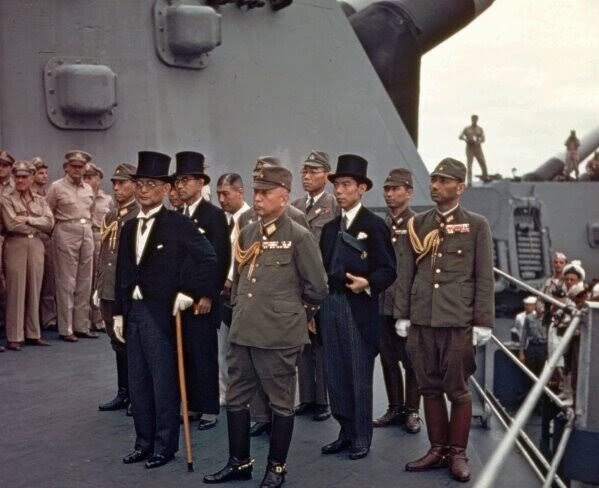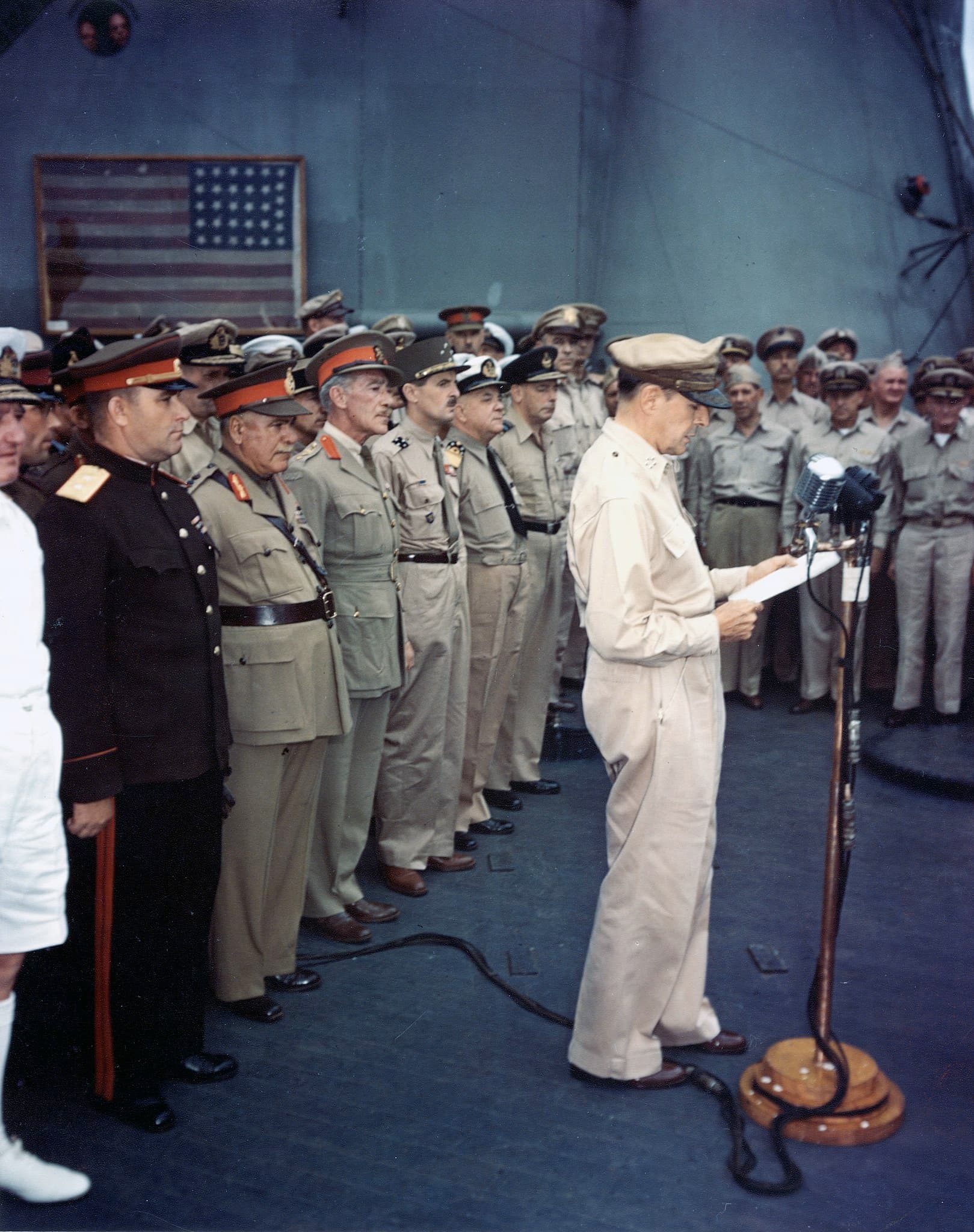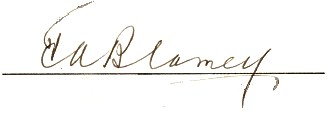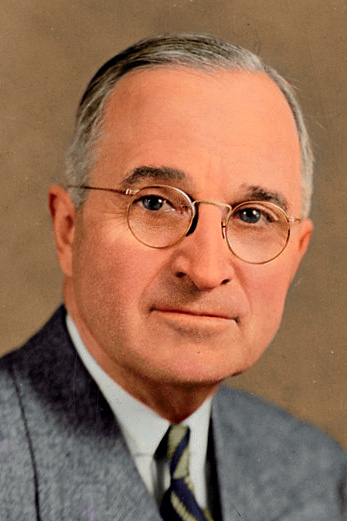Youngstown Vindicator (September 2, 1945)
General to be just and tolerant, urges people at home care for returning fighting men
By Spencer Davis, Associated Press staff writer

ABOARD USS MISSOURI, TOKYO BAY (AP, Sept. 2) – Japan formally yielded to the overwhelming might of the Allies this morning (Saturday night ET) in a solemn 22-minute surrender ceremony aboard the mighty battleship Missouri in Tokyo Bay, restoring peace once more to a war-ravaged world.
Twelve signatures, requiring only a few minutes to inscribe on the articles of surrender, ended the bloody Pacific conflict, which had entered its eighth year in China and had raged almost three years and nine months for the United States and Great Britain.
All issues have been “determined on the battleships of the world and hence are not for our discussion or debate,” Gen. Douglas MacArthur said preliminary to inviting all representatives to sign the surrender instrument.
Two Jap leaders sign document
He added:
Nor is it for us here to meet, representing as we do the majority of the peoples of the earth, in a spirit of distrust, malice or hatred.
But rather it is for us, both victors and vanquished, to rise to that higher dignity which alone benefits the sacred purposes we are about to serve…
On behalf of Emperor Hirohito, Foreign Minister Mamoru Shigemitsu signed for the government and Gen. Yoshijiro Umezu for the Imperial General Staff.
MacArthur uses five pens
Gen. MacArthur then signed in behalf of the United Nations using five pens and declaring:
It is my earnest hope and indeed the hope of all mankind that from this solemn occasion a better world shall emerge out of the blood and carnage of the past.
After the signing, Gen. MacArthur said:
And so, my fellow countrymen, today I report to you that your sons and daughters have served you well and faithfully with the calm, deliberate, determined fighting spirit of the American soldier and sailor based upon a tradition of historical trait, as against the fanaticism of an enemy supported only by mythological fiction. Their spiritual strength and power has brought us through to victory. They are homeward bound – take care of them.
One document was in Japanese – suitably bound in black. The other, in English, was for the United Nations – bound in green and gold.
Shigemitsu signed first for Japan. He doffed his top hat, tinkered with the pen and then firmly affixed his signature to the surrender document, a paper about 12 by 18 inches.
Shigemitsu carefully signed the American copy first, then affixed his name to a duplicate copy to be retained by Japan.
Shigemitsu’s fumbling and delay of several moments before signing was the only departure from the efficient, smoothly-working procedure.
Shigemitsu searches for pen
When he took his seat at the table, Shigemitsu searched through his pockets, apparently seeking a pen. Lt. Gen. Richard K. Sutherland, MacArthur’s chief of staff, stepped up to help Shigemitsu gain composure.
The Japanese foreign minister then carefully studied a watch. When MacArthur suddenly appeared irritated by the delay, Shigemitsu drew another watch and considered it. Then he dipped his pen in the ink, leaned over the paper and began the signature.
Following him, Gen. Umezu sat down resolutely, and scrawled his name on the documents as if in a tremendous hurry.
A Japanese colonel present was seen to wipe tears from his eyes as the general signed. All the Japanese looked tense and weary but maintained impassivity throughout.
Shigemitsu looked on anxiously as Umezu signed.
MacArthur’s five pens included his own fountain pen, produced from a pocket with a brief smile, and a “G.I.” pen.
MacArthur’s hand shook slightly as he reached “Dou–” in his first signature. His face twitched but his voice was strong although he appeared to be under great emotional strain.
The supreme commander exchanged salutes gravely with each of the United Nations representatives as they stepped forward to sign.
First to sign was Admiral Chester W. Nimitz for the United States, then the representatives of China, the United Kingdom, Russia, Australia, Canada, France, Netherlands and New Zealand.
Other Allied signers listed
The other signers were: Gen, Hsu Yung-Chang for China, Adm. Sir Bruce Fraser for Great Britain, Lt. Gen. Kuzma Derevyanko for Russia, Gen. Sir Thomas Blamey for Australia, Col. L. Moore Cosgrave for Canada, Gen. Jacques LeClerc for France, Lt. Gen, L. H. Van Oyen for the Netherlands; Air Vice Marshal L. M. Isitt for New Zealand.
The flags of the United States, Britain, Russia and China fluttered from the veranda deck of the famed super-dreadnaught, polished and scrubbed as never before.
The Japanese delegation came aboard at (7:55 p.m. Saturday ET) as scheduled. They reached the Missouri in personnel speedboats flying the American flag.
Shigemitsu led the delegation. He climbed stiffly up the ladder and limped forward on his right leg, which is artificial.
When MacArthur boarded the ship, followed by Nimitz and other high-ranking officials, a tense expression and slightly shaking hands were his only signs of emotions.
MacArthur smiles at Wainwright
MacArthur smiled briefly at the lanky Wainwright as he passed and then his look became grim as he stared at the Japanese representatives for one long moment. Then the supreme commander began his address opening the surrender ceremony.
More than 100 high-ranking military and naval officers watched.
All Allied representatives were sober-faced, but obviously glad it’s over. Soldiers, sailors and Marines, some of whom had fought their way across the Pacific, hardly could hide a trace of exuberance on their serious faces.
Surrender hour was cool and cloudy, but the sun broke through the overcast 20 minutes later as MacArthur intoned “these proceedings are closed.”
When the ceremony was completed, Shigemitsu’s aid received the Japanese copy. Then the Japanese protested that someone had signed on the wrong line, but that squabble was settled quickly. Blamey, representing Australia, signed the Japanese document first – by error – then shrugged as if it really made no difference, now.
The ceremony was conducted on the Missouri’s gallery deck. A long table was set up for the signing. Every available inch of space was crowded with army, navy and marine spectators and about 200 correspondents.
There were 11 Japanese representatives. All were dressed formally or were in uniform, except one who wore a rumpled white linen suit.
The Japanese representatives were present at the command of Emperor Hirohito contained in a proclamation “issued by order of the Supreme Allied Commander in connection with Japan’s formal surrender.”
Hirohito bows to MacArthur
The emperor further commanded his officials “to issue general orders to the military and naval forces in accordance with the direction of the Supreme Commander of the Allied Powers.”
Thus Emperor Hirohito formally acknowledged that Gen. MacArthur’s word in Japan will come foremost of all Nipponese officialdom during the Allied occupation of the country, which never before had been occupied by an alien force.
The emperor said:
I command all my people forthwith to cease hostilities, to lay down their arms and faithfully to carry out all the provisions of the instrument of surrender and the general orders issued by the imperial general headquarters hereunder.
Wainwright gets his chance
MacArthur told the Japanese:
As Supreme Commander for the Allied Powers, I announce it my firm purpose in the tradition of the countries I represent to proceed in the discharge of my responsibilities with justice and tolerance, while taking all necessary dispositions to insure that the terms of surrender are fully, promptly and faithfully complied with.”
After the last signature had been affixed, MacArthur turned and presented surrender pens to Lt. Gen. Jonathan M. Wainwright, hero of Corregidor, and Lt. Gen. A. E. Percival, British defender of Singapore when it was overrun by the Japanese.
All through this dramatic half hour, only those aboard the battleship knew of what was transpiring because the Missouri has no broadcasting facilities.
Recordings made of ceremony
But recordings were rushed to the near-by communications ship USS Ancon, and the solemn words of MacArthur beginning the ceremony – “we are gathered here, representatives of the major warring powers” – were flashed around the world.
The hour for which all liberty-loving lands the world over had awaited for long and terrible years was at hand – V-J Day was here.
Yet at the hour of triumph, the world was sobered by the knowledge of the price which civilization paid to achieve this day, and that theme rang through the messages of America’s commanders.
“Our first thoughts of course – thoughts of gratefulness and deep obligation – go out to those of our loved ones who have been killed or maimed in this terrible war,” President Truman told the world from a broadcasting room in the White House in Washington. And there, where the Japanese warlords had once boasted they would dictate their own peace terms. Truman spoke these determined words: “We shall not forget Pearl Harbor. The Japanese militarists will not forget the USS Missouri.” And, after he had proclaimed the peace “a victory of liberty over tyranny.”
‘Great tragedy has ended’
In this bay near Japan’s ruined capital, MacArthur told his countrymen: “Today the guns are silent. A great tragedy has ended. A great victory has been won.”
The Supreme Allied Commander said he spoke “for the thousands of silent lips, forever stilled among the jungles and the beaches and in the deep waters of the Pacific which marked the way.”
He continued:
As I look back on the long, tortuous trail from those grim days of Bataan and Corregidor, when an entire world lived in fear, when democracy was on the defensive everywhere, when modern civilization trembled in the balance, I thank a merciful God that He has given us the faith, the courage and the power from which to mold victory.
Nimitz praises fighting men
Possibly thinking of the atomic bomb that hastened Japan’s decision to surrender. MacArthur declared that the war had become so utterly destructive that unless an equitable system of peace was devised “Armageddon will be at our door.”
Nimitz, speaking next and praising all branches of the services and the Allies, declared that the United Nations must “enforce rigidly the peace terms that will be imposed upon Japan.”
The President included in his eulogy “our departed gallant leader, Franklin D. Roosevelt, a defender of democracy, architect of world peace and cooperation.”
Nimitz said he took “great pride in the American forces which have helped to win this victory,” and declared that “America can be proud of them.”
Nimitz said:
The officers and men of the United States Army, Navy, Marine Corps, Coast Guard and Merchant Marine who fought in the Pacific have written heroic new chapters in this nation’s military history.
I have infinite respect for their courage, resourcefulness and devotion to duty. We also acknowledge the great contribution to this victory made by our valiant allies. United we fought and united we prevail.
Out to Japanese field commanders went Emperor Hirohito’s orders, issued after the articles were signed, commanding “all my people forthwith to cease hostilities to lay down their arms and faithfully to carry out all provisions of the instrument of surrender.”
By the signatures of his plenipotentiaries, Emperor Hirohito accepted the terms of the Potsdam declaration which called for the elimination “for all time” of those who led Japan to war and stern justice for war criminals.
Now Japan’s sovereignty was limited to the will of the Allies, all her conquests were stripped away, and she was left completely disarmed.
Bay scene of great activity
The setting in which the momentous document was signed testified to the thoroughness with which Japan was beaten to her knees.
Tokyo Bay itself today was a scene of feverish activity, with boats plying back and forth in preparation for the history-making event.
The Navy combat squadrons lay at anchor in impressive array – the long lines of grey battlewagons that scourged the Pacific and finally invaded the hitherto inviolate waters of Japan herself.
Overhead Allied planes flew in vigilant patrol. Gen. Carl Spaatz, commander of the Strategic Air Forces, declared his planes were ready to loose 8,000 tons of bombs at any sign of treachery,
Strategic points seized
On both sides of the bay and up to the Tama River at the southern edge of Tokyo, American troops and British and American Marines and bluejackets were in firm control. All strategic points had been seized.
The ruined capital of Tokyo itself was reported out-of-bounds for troops, but soon its bomb-blackened streets will echo to the tramp of Allied forces.
MacArthur will shift his headquarters from this once-great port of Tokyo to the capital itself, setting up in the U.S. embassy. The embassy was only slightly damaged by the great fire raids.
The men whose forces met and defeated the would-be overlords of the Orient were gathered here with their staffs and aides to sign the articles of surrender or to witness them.
With Gen. Wainwright at McArthur’s invitation were Wainwright’s officers at Corregidor. From here, Wainwright plans to go to Washington in a few days.











